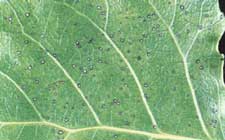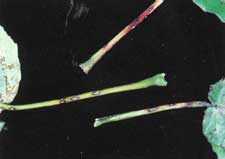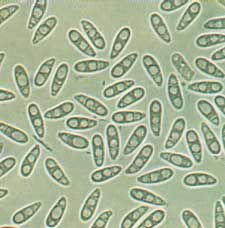Marssonina BlightMichael E. Ostry - Plant Pathologist, North Central Forest Experiment Station, USDA Forest Service, St. Paul, MN, and Cordell C.E., Anderson R.L., Hoffard W.H., Landis T.D., Smith R.S. Jr., Toko H.V., 1989. Forest Nursery Pests. USDA Forest Service, Agriculture Handbook No. 680, 184 pp. Hosts Marssonina blight, caused by the fungi Marssonina brunnea, M. populi, and M. castagnei, affects all species of aspen and poplars native to North America. The pathogens can also damage many introduced poplar species and hybrids. Possible hybridization or mutation in the genus Marssonina has resulted in host-specific forms of the fungi. Distribution Species of Marssonina are found throughout their hosts' known range. International transport of poplar cuttings may have contributed to the spread of the pathogens. Damage The blight can cause premature defoliation, resulting in significant growth reduction and, on occasion, mortality. Damage can be especially severe where poplar species and clones are selected without regard to their susceptibility to the disease. Diagnosis Leaf symptoms vary, depending upon the susceptibility of the poplar species or hybrid, the species of Marssonina, and the severity of infection. Look for small, brownish, circular to angular spots, 1 to 2 mm across. These spots develop on the surface of leaves in spring and early summer (fig. 33-1). The center of the spot usually appears whitish. Spots may eventually join to form large, angular, rust-brown to black necrotic blotches (fig. 33-2).
Biology Marssonina overwinters in lesions on infected stems and on fallen leaves. In the spring during wet weather, the fungus releases ascospores and possibly conidia, which were produced on fallen leaves or on lesions produced during the previous growing season. The spores are carried by wind and rain splash. Leaves, petioles, and succulent stems of susceptible seedlings become infected, resulting in leaf spots and shoot lesions. During the summer, conidia produced on these lesions are exuded in masses and disseminated by rain splash and wind to adjacent leaves and stems. Control Prevention - Several poplar hybrids have been identified as being resistant or tolerant to Marssonina. Where possible, these clones should be used for planting. Cultural - Examine nursery stock for Marssonina infection. Cull infected hardwood cuttings to avoid spreading the fungus on planting stock. Remove and destroy or plow under diseased plant debris. Reduce planting density to improve air movement. When possible, avoid overhead irrigation systems. Chemical - No chemicals are registered to control this disease on poplars in nurseries. Selected References Boyer. M.G. 1961. Variability of hyphal anastomoses in host-specific forms of Marssonina populi (Lib.) Magn. Canadian Journal of Botany. 39: 1409-1427. Dochinger. Leon S. 1975. Marssonina blight of bigtooth aspen. In: Peterson, Glenn W.; Smith. Richard S., Jr. tech. coords. Forest nursery diseases in the United States. Agric. Handb. 470. Washington. DC: U.S. Department of Agriculture: 95-98. Ostry, ME. 1987. Biology of Septoria musiva and Marssonina brunnea in hybrid Populus plantations and control of Septoria canker in nurseries. European Journal of Forest Pathology. 17: 158-165. Palmer. M.A.; Ostry, ME.; Schipper. A.L. Jr., 1980. How to identify and control Marssonina leaf spot of poplars. St. Paul, MN: U.S. Department of Agriculture. Forest Service, North Central Forest Experiment Station. Spiers. AG. 1984. Comparative studies of host specificity and symptoms exhibited by poplars infected with Marssonina brunnea, Marssonina castagnei . and Marssonina populi. European Journal of Forest Pathology. 14: 202-218. Watkins, John E; Wysong, David S. 1986. Marssonina leaf blight of cottonwood and aspen. In: Riffle, Jerry W.; Peterson, Glenn W.; tech. coords. Diseases of trees in the Great Plains, Gen. Tech. Rep. RM-129. Fort Collins, CO: U.S. Department of Agriculture. Forest Service, Rocky Mountain Forest and Range Experiment Station: 6-7. |
Forest Pests: Insects, Diseases & Other Damage Agents |

|
|





